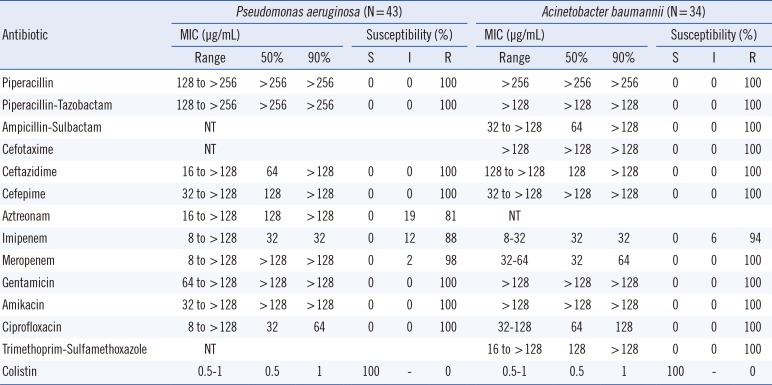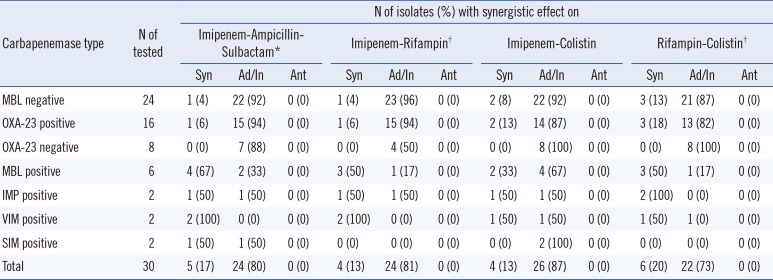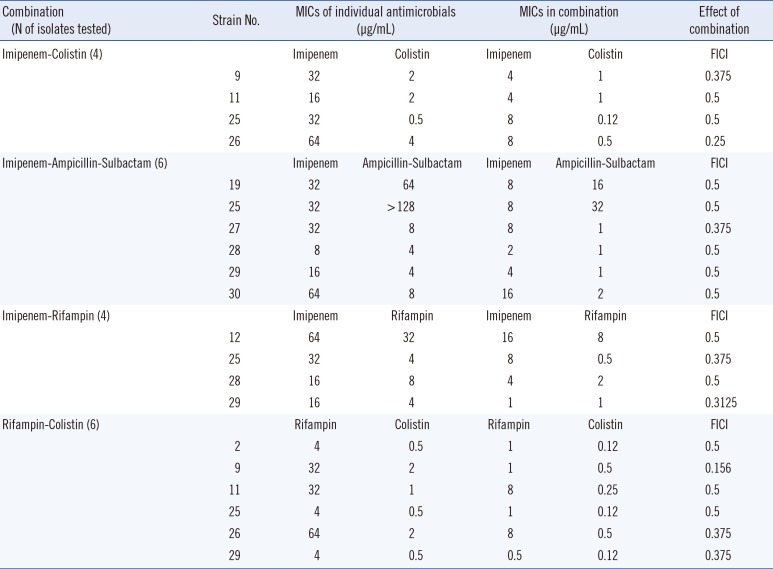1. Lister PD, Wolter DJ, Hanson ND. Antibacterial-resistant
Pseudomonas aeruginosa: clinical impact and complex regulation of chromosomally encoded resistance mechanisms. Clin Microbiol Rev. 2009; 22:582–610. PMID:
19822890.
2. Peleg AY, Seifert H, Paterson DL.
Acinetobacter baumannii: emergence of a successful pathogen. Clin Microbiol Rev. 2008; 21:538–582. PMID:
18625687.
3. Lee K, Kim MN, Kim JS, Hong HL, Kang JO, Shin JH, et al. Further increases in carbapenem-, amikacin-, and fluoroquinolone-resistant isolates of
Acinetobacter spp. and
P. aeruginosa in Korea: KONSAR study 2009. Yonsei Med J. 2011; 52:793–802. PMID:
21786445.
4. Huh K, Kim J, Cho SY, Ha YE, Joo EJ, Kang CI, et al. Continuous increase of the antimicrobial resistance among gram-negative pathogens causing bacteremia: a nationwide surveillance study by the Korean Network for Study on Infectious Diseases (KONSID). Diagn Microbiol Infect Dis. 2013; 76:477–482. PMID:
23721721.

5. Koch-Weser J, Sidel VW, Federman EB, Kanarek P, Finer DC, Eaton AE. Adverse effects of sodium colistimethate. Manifestations and specific rates during 317 courses of therapy. Ann Intern Med. 1970; 72:857–868. PMID:
5448745.
6. Li J, Nation RL. Old polymyxins are back: is resistance close? Clin Infect Dis. 2006; 43:663–664. PMID:
16886164.

7. Bergen PJ, Li J, Nation RL. Dosing of colistin-back to basic PK/PD. Curr Opin Pharmacol. 2011; 11:464–469. PMID:
21835694.

8. Taccone FS, Rodriguez-Villalobos H, De Backer D, De Moor V, Deviere J, Vincent JL, et al. Successful treatment of septic shock due to pan-resistant
Acinetobacter baumannii using combined antimicrobial therapy including tigecycline. Eur J Clin Microbiol Infect Dis. 2006; 25:257–260. PMID:
16572310.
9. Dean CR, Visalli MA, Projan SJ, Sum PE, Bradford PA. Efflux-mediated resistance to tigecycline (GAR-936) in
Pseudomonas aeruginosa PAO1. Antimicrob Agents Chemother. 2003; 47:972–978. PMID:
12604529.
10. Navon-Venezia S, Leavitt A, Carmeli Y. High tigecycline resistance in multidrug-resistant
Acinetobacter baumannii. J Antimicrob Chemother. 2007; 59:772–774. PMID:
17353223.
11. Peleg AY, Adams J, Paterson DL. Tigecycline efflux as a mechanism for nonsusceptibility in
Acinetobacter baumannii. Antimicrob Agents Chemother. 2007; 51:2065–2069. PMID:
17420217.
12. Petrosillo N, Ioannidou E, Falagas ME. Colistin monotherapy vs. combination therapy: evidence from microbiological, animal and clinical studies. Clin Microbiol Infect. 2008; 14:816–827. PMID:
18844682.

13. Tamma PD, Cosgrove SE, Maragakis LL. Combination therapy for treatment of infections with gram-negative bacteria. Clin Microbiol Rev. 2012; 25:450–470. PMID:
22763634.

14. Zavascki AP, Bulitta JB, Landersdorfer CB. Combination therapy for carbapenem-resistant Gram-negative bacteria. Expert Rev Anti Infect Ther. 2013; 11:1333–1353. PMID:
24191943.

15. Zusman O, Avni T, Leibovici L, Adler A, Friberg L, Stergiopoulou T, et al. Systematic review and meta-analysis of in vitro synergy of polymyxins and carbapenems. Antimicrob Agents Chemother. 2013; 57:5104–5111. PMID:
23917322.
16. Clinical and Laboratory Standards Institute. Performance standard for antimicrobial susceptibility testing. Twenty-third Informational supplement; approved guideline, M100-S23. Wayne, PA: Clinical and Laboratory Standards Institute;2013.
17. Lee K, Kim CK, Yong D, Jeong SH, Yum JH, Seo YH, et al. Improved performance of the modified Hodge test with MacConkey agar for screening carbapenemase-producing Gram-negative bacilli. J Microbiol Methods. 2010; 83:149–152. PMID:
20801167.

18. Lee K, Lim YS, Yong D, Yum JH, Chong Y. Evaluation of the Hodge test and the imipenem-EDTA double-disk synergy test for differentiating metallo-beta-lactamase-producing isolates of
Pseudomonas spp. and
Acinetobacter spp. J Clin Microbiol. 2003; 41:4623–4629. PMID:
14532193.
19. Lee K, Kim MN, Choi TY, Cho SE, Lee S, Whang DH, et al. Wide dissemination of OXA-type carbapenemases in clinical
Acinetobacter spp. isolates from South Korea. Int J Antimicrob Agents. 2009; 33:520–524. PMID:
19091520.
20. Hindler JF, Munro S. Evaluating antimicrobial susceptibility test. In : Garcia LS, Isenberg HD, editors. Clinical microbiology procedures handbook. 3rd ed. Washington DC: ASM Press;2010. p. 5.0.1–5.18.2.1.
21. Biswas S, Brunel JM, Dubus JC, Reynaud-Gaubert M, Rolain JM. Colistin: an update on the antibiotic of the 21st century. Expert Rev Anti Infect Ther. 2012; 10:917–934. PMID:
23030331.

22. Dhariwal AK, Tullu MS. Colistin: re-emergence of the 'forgotten' antimicrobial agent. J Postgrad Med. 2013; 59:208–215. PMID:
24029199.

23. García-Quintanilla M, Pulido MR, Moreno-Martínez P, Martín-Peña R, López-Rojas R, Pachón J, et al. Activity of host antimicrobials against multidrug-resistant
Acinetobacter baumannii acquiring colistin resistance through loss of lipopolysaccharide. Antimicrob Agents Chemother. 2014; 58:2972–2975. PMID:
24566189.
24. Lee JY, Na IY, Park YK, Ko KS. Genomic variations between colistin-susceptible and -resistant
Pseudomonas aeruginosa clinical isolates and their effects on colistin resistance. J Antimicrob Chemother. 2014; 69:1248–1256. PMID:
24474431.
25. Matthaiou DK, Michalopoulos A, Rafailidis PI, Karageorgopoulos DE, Papaioannou V, Ntani G, et al. Risk factors associated with the isolation of colistin-resistant gram-negative bacteria: a matched case-control study. Crit Care Med. 2008; 36:807–811. PMID:
18431267.

26. Kim Y, Bae IK, Lee H, Jeong SH, Yong D, Lee K. In vivo emergence of colistin resistance in
Acinetobacter baumannii clinical isolates of sequence type 357 during colistin treatment. Diagn Microbiol Infect Dis. 2014; 79:362–366. PMID:
24809861.
27. Galani I, Kontopidou F, Souli M, Rekatsina PD, Koratzanis E, Deliolanis J, et al. Colistin susceptibility testing by Etest and disk diffusion methods. Int J Antimicrob Agents. 2008; 31:434–439. PMID:
18328674.

28. Hindler JA, Humphries RM. Colistin MIC variability by method for contemporary clinical isolates of multidrug-resistant Gram-negative bacilli. J Clin Microbiol. 2013; 51:1678–1684. PMID:
23486719.

29. Landman D, Bratu S, Alam M, Quale J. Citywide emergence of
Pseudomonas aeruginosa strains with reduced susceptibility to polymyxin B. J Antimicrob Chemother. 2005; 55:954–957. PMID:
15883174.
30. Gunderson BW, Ibrahim KH, Hovde LB, Fromm TL, Reed MD, Rotschafer JC. Synergistic activity of colistin and ceftazidime against multiantibiotic-resistant
Pseudomonas aeruginosa in an in vitro pharmacodynamic model. Antimicrob Agents Chemother. 2003; 47:905–909. PMID:
12604520.
31. Timurkaynak F, Can F, Azap OK, Demirbilek M, Arslan H, Karaman SO. In vitro activities of non-traditional antimicrobials alone or in combination against multidrug-resistant strains of
Pseudomonas aeruginosa and
Acinetobacter baumannii isolated from intensive care units. Int J Antimicrob Agents. 2006; 27:224–228. PMID:
16464562.
32. Cirioni O, Ghiselli R, Silvestri C, Kamysz W, Orlando F, Mocchegiani F, et al. Efficacy of tachyplesin III, colistin, and imipenem against a multiresistant
Pseudomonas aeruginosa strain. Antimicrob Agents Chemother. 2007; 51:2005–2010. PMID:
17403995.
33. Tascini C, Gemignani G, Ferranti S, Tagliaferri E, Leonildi A, Lucarini A, et al. Microbiological activity and clinical efficacy of a colistin and rifampin combination in multidrug-resistant
Pseudomonas aeruginosa infections. J Chemother. 2004; 16:282–287. PMID:
15330326.
34. Choi JY, Park YS, Cho CH, Park YS, Shin SY, Song YG, et al. Synergic in-vitro activity of imipenem and sulbactam against
Acinetobacter baumannii. Clin Microbiol Infect. 2004; 10:1098–1101. PMID:
15606639.
35. Song JY, Cheong HJ, Lee J, Sung AK, Kim WJ. Efficacy of monotherapy and combined antibiotic therapy for carbapenem-resistant
Acinetobacter baumannii pneumonia in an immunosuppressed mouse model. Int J Antimicrob Agents. 2009; 33:33–39. PMID:
18835761.
36. Pachón-Ibáñez ME, Docobo-Pérez F, Jiménez-Mejias ME, Ibáñez-Martínez J, García-Curiel A, Pichardo C, et al. Efficacy of rifampin, in monotherapy and in combinations, in an experimental murine pneumonia model caused by panresistant
Acinetobacter baumannii strains. Eur J Clin Microbiol Infect Dis. 2011; 30:895–901. PMID:
21336548.
37. Liang W, Liu XF, Huang J, Zhu DM, Li J, Zhang J. Activities of colistin- and minocycline-based combinations against extensive drug resistant
Acinetobacter baumannii isolates from intensive care unit patients. BMC Infect Dis. 2011; 11:109. PMID:
21521536.

38. Lee HJ, Bergen PJ, Bulitta JB, Tsuji B, Forrest A, Nation RL, et al. Synergistic activity of colistin and rifampin combination against multidrug-resistant
Acinetobacter baumannii in an in vitro pharmacokinetic/pharmacodynamic model. Antimicrob Agents Chemother. 2013; 57:3738–3745. PMID:
23716052.
39. Wareham DW, Bean DC. In-vitro activity of polymyxin B in combination with imipenem, rifampicin and azithromycin versus multidrug resistant strains of
Acinetobacter baumannii producing OXA-23 carbapenemases. Ann Clin Microbiol Antimicrob. 2006; 5:10. PMID:
16630352.
40. Khawcharoenporn T, Pruetpongpun N, Tiamsak P, Rutchanawech S, Mundy LM, Apisarnthanarak A. Colistin-based treatment for extensively drug-resistant
Acinetobacter baumannii pneumonia. Int J Antimicrob Agents. 2014; 43:378–382. PMID:
24613422.








 PDF
PDF ePub
ePub Citation
Citation Print
Print


 XML Download
XML Download